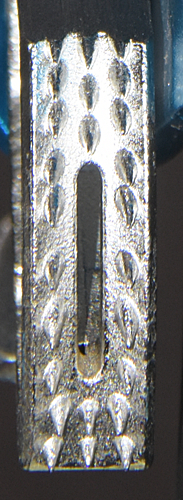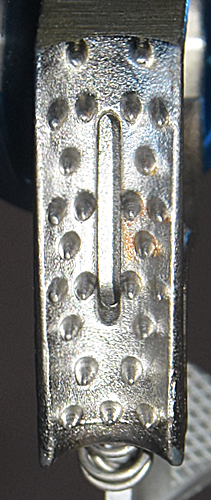Overview
[ Top
| Version B
| Return to E.C. Ascenders
]
Version A
(#2015)
Technical Details
I acquired my NTR from Linko Chen 训连 陈, 2015.
 The NTR is 117 mm. tall, 82 mm. wide, 35 mm. thick, and weighs 160 g. The ascender shell is subtriangular
blue anodized shape bent from 4 mm. aluminum sheet. The
rope channel is formed by bending the right side of the ascender
into a U. The rope channel is 15 mm. wide. The main sling attachment point is located below the cam and behind the
rope channel. A second attachment point is located above the cam,
also behind the rope channel. The shell is bent backwards at both
points to provide clearance between the attachment slings and
the main rope. This accounts for the rather large thickness of
this ascender. The attachment points appear to be ovals distorted
by the stamping operation. The lower attachment point measures
23.2 by 19.6 mm. and the upper 17.7 by 15.6 mm. The left side
of the shell is bent on an inclined axis to form another U. A
hole drilled through both sides of the U accepts a semi-tubular rivet.
The cam and cam spring are mounted on this rivet. The pivot is centered
48 mm. from the inside of the rope channel.
The NTR is 117 mm. tall, 82 mm. wide, 35 mm. thick, and weighs 160 g. The ascender shell is subtriangular
blue anodized shape bent from 4 mm. aluminum sheet. The
rope channel is formed by bending the right side of the ascender
into a U. The rope channel is 15 mm. wide. The main sling attachment point is located below the cam and behind the
rope channel. A second attachment point is located above the cam,
also behind the rope channel. The shell is bent backwards at both
points to provide clearance between the attachment slings and
the main rope. This accounts for the rather large thickness of
this ascender. The attachment points appear to be ovals distorted
by the stamping operation. The lower attachment point measures
23.2 by 19.6 mm. and the upper 17.7 by 15.6 mm. The left side
of the shell is bent on an inclined axis to form another U. A
hole drilled through both sides of the U accepts a semi-tubular rivet.
The cam and cam spring are mounted on this rivet. The pivot is centered
48 mm. from the inside of the rope channel.
The cam is a stainless steel casting with
an open web.
The cam radius increases from 38 to 57 mm. over an angle of 44°, giving a 28° cam angle. The cam has number of small conical teeth, all of which have their axes approximately aligned with the cam axle. The tooth pattern is
(3)^3(1S1)^5(3)^2.
A spring-loaded manual safety tab is mounted on the bottom of the cam with a steel semi-tubular rivet. The normal action of the spring holds the safety against the cam. When the cam is opened, the shell interferes with the safety bar, thus preventing opening the cam. If the safety bar is moved away from the cam (opposing the spring), it will clear the shell and the cam will open. At full open the safety can be released and the spring will hold the safety against the back of the shell. This provides a means of locking the cam open.
The front of the NTR is printed with an arrow labeled "UP," "MAX 4kN," and "ROPE:Ø8-12MM." The rear is printed with "NTR" and "CE 1019 EN567."
The NTR is one of the following group of closely-related chest ascenders:
I obtained most of these from China. The others (e.g., the International Safety
Components and WestFall Pro from the U.K., the Rock Empire from the Czech Republic, the Vento from Russia) were made in China as well. These are all well-made ascenders and the prices that I paid, even with shipping, were far below those of the European-made equivalents. One potential concern is that we don't have the experience with Chinese metallurgy and quality control that we have with American and European devices, but I have no evidence suggesting that the metallurgy is unacceptable and the quality certainly appears to be fine. I'm not making any recommendation on this point one way or the other.
All sharp edges have been
removed, except for those on the inside of the attachment holes on a few of these. The user should round the attachment holes with a Swiss file.
The cams are all very well made. There are two distinct cam types, "symmetrical" and "asymmetrical." The reverse side behind the cam face is parallel to the cam axle on the symmetrical cams, and sloped on the asymmetrical cams. This has no practical significance. The asymmetrical cams have a (3)^3(2)(1S1)^4(3)^2 tooth pattern while the slot in the symmetrical cams is slightly longer (extending to between the top tooth pair), giving a (3)^3(1S1)^5(3)^2 tooth pattern. This also has no practical significance.
Another minor difference is that the cam rivet on the Yoke has a smaller head than the ones on the others.
All of these have aluminum tab cam safeties, but the ones on the GM Climbing and Rock Empire are plastic-covered. I don't find a particular advantage or disadvantage to the plastic tab, but one may have a personal preference. Mine is to save weight by choosing one without the plastic cover.
[ Top
| Version A
| Return to E.C. Ascenders
]
Version B
(#2085)
Technical Details
I acquired my NTR, Version B as part of Bob Thrun’s collection.
 The NTR, Version B is 110 mm. tall, 74 mm. wide, 34 mm. thick, and weighs 134 g. The ascender shell is subtriangular
shape bent from 3.9 mm. aluminum sheet. The
rope channel is formed by bending the left side of the ascender
into a U. The rope channel is 16 mm. wide. The main sling attachment point is located below the cam and behind the
rope channel. A second attachment point is located above the cam,
also behind the rope channel. The shell is bent backwards at both
points to provide clearance between the attachment slings and
the main rope. This accounts for the rather large thickness of
this ascender. The attachment points are pear-shaped openings distorted
by the stamping operation. The lower attachment point measures
21.4 by 20.8 mm. and the upper 26.9 by 18.0 mm. The right side
of the shell is bent on an inclined axis to form another U. A
hole drilled through both sides of the U accepts a semi-tubular rivet.
The cam and cam spring are mounted on this rivet. The pivot is centered 48
mm. from the inside of the rope channel.
The NTR, Version B is 110 mm. tall, 74 mm. wide, 34 mm. thick, and weighs 134 g. The ascender shell is subtriangular
shape bent from 3.9 mm. aluminum sheet. The
rope channel is formed by bending the left side of the ascender
into a U. The rope channel is 16 mm. wide. The main sling attachment point is located below the cam and behind the
rope channel. A second attachment point is located above the cam,
also behind the rope channel. The shell is bent backwards at both
points to provide clearance between the attachment slings and
the main rope. This accounts for the rather large thickness of
this ascender. The attachment points are pear-shaped openings distorted
by the stamping operation. The lower attachment point measures
21.4 by 20.8 mm. and the upper 26.9 by 18.0 mm. The right side
of the shell is bent on an inclined axis to form another U. A
hole drilled through both sides of the U accepts a semi-tubular rivet.
The cam and cam spring are mounted on this rivet. The pivot is centered 48
mm. from the inside of the rope channel.
The cam is a stainless steel casting with a hybrid form consising of a large opening behind the mud slot, a smaller oepning behind this, and a reinforced partial web filling the remainder. The cam radius increases from 36 to 52 mm. over an angle of 38°, giving a 30° cam angle. The cam has number of small conical sloping teeth. The tooth pattern is (2.4)(1S1.2S2)^2(1S1)(2.3) where the "S" represents a single longitudinal mud slot. Like many other ascenders, the inner cam face radius reduces from top to bottom to accommodate various sized ropes.
A spring-loaded manual safety tab is attached to the cam with a semi-tubular rivet. The safety is stamped from 2.5 mm. aluminum alloy. The lower portion is bent outward about 60° to form a thumb tab. The top of the tab has a stamped checkered pattern. The spring is a compression spring that fits over a post on the base of the cam and a small tab on the stamped safety. The normal action of the spring holds the safety against the cam. When the cam is opened, the shell interferes with the safety, thus preventing opening the cam. If the safety is moved away from the cam (opposing the spring), it will clear the shell and the cam will open. At full open the safety can be released and the spring will hold the safety against the back of the shell. This provides a means of locking the cam open.
The front of the ascender is printed with "ROPE O9<Ø<13," "UP," and "MAX 4kN." The back is printed with "NTR," "CE 1019," and "EN567."
NTR, Version B is essentially identical to the Proverti 201L. These right-handed chest ascenders are unique, as almost all other stamped frame chest ascenders in my collection are left-handed.
In general I feel that this is a well made ascender. All sharp
edges have been removed. The cam teeth are rather well done. The tab on the safety is rather small and slopes downward, allowing one’s thumb to slip off rather easily.
[ Top
| Version A
| Version B
]


